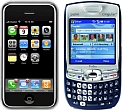A third of all phones “smart” in five years
Mar 20, 2008 — by LinuxDevices Staff — from the LinuxDevices Archive — viewsThe smartphone market will grow from around 10 percent of total handset sales in 2007 to 31 percent in 2013, says an ABI Research study. Future phones will boast such luxuries as touchpads, tilt/shock sensors, and tactile feedback, says the study, with Linux and Windows Mobile increasingly challenging Nokia/Symbian.
 The report cites the “iPhone effect, filtering through the handset market as other OEMs strive to remain competitive,” as one driver for growth. But other factors are said to be carriers' desire to grow data revenues from advanced services, and the general trend to pushing “smart” operating systems down into middle-tier devices.
The report cites the “iPhone effect, filtering through the handset market as other OEMs strive to remain competitive,” as one driver for growth. But other factors are said to be carriers' desire to grow data revenues from advanced services, and the general trend to pushing “smart” operating systems down into middle-tier devices.
ABI Research vice president Stuart Carlaw said, “The market is currently dominated by Nokia (52 percent) and Symbian (65 percent). However, the coalescence of the framework wars in the Linux environment and the growing stature of Windows Mobile will enable new competitors to put pressure on this established axis.”
The complete 115-page study, “Smartphone and OS Markets,” is touted as including forecasts for handset shipments from 2005 to 2013, broken down by region, technologies, operating systems, and revenues. While the company's summary did not include numbers, a related September 2007 report by ABI has said more than 100 million handsets with touch screens will be shipped in 2008, and more than 500 million will ship by 2012.
Noting recent developments such as Nokia's pending acquisition of Trolltech, the report takes time to define the essential features of a “smartphone,” such as:
- A commercial operating system
- A larger than average color display
- Advanced input, such as a keyboard, touchscreen, or voice-driven interface
Phones will be increasingly likely to include GPS, tactile feedback, and MEMS (micro electro-mechanical system) accelerometers. They will thereby offer features such as situational awareness, exercise and health monitoring, tilt-sensing, and new user interface features, according to ABI.
Interestingly, while the report discusses smartphone features such as push email, VoIP, and wireless local area networking, it apparently does not mention “4G” technologies such as LTE (long-term evolution), UMB (ultra-mobile broadband), and WiMAX, implying that they are not expected to drive smartphone sales in the near term. A recent study by In-Stat predicted slow uptake of 4G, with initial implementations occurring in 2010.
Further information
ABI Research did not release pricing for the report, “Smartphone and OS Markets.” More information may be available from the company's website, here.
This article was originally published on LinuxDevices.com and has been donated to the open source community by QuinStreet Inc. Please visit LinuxToday.com for up-to-date news and articles about Linux and open source.